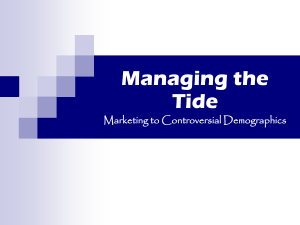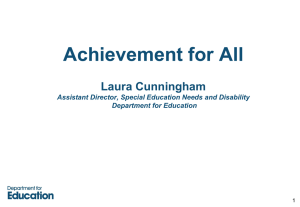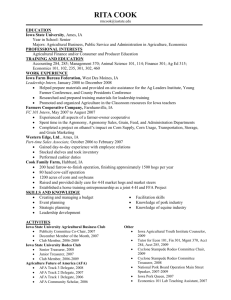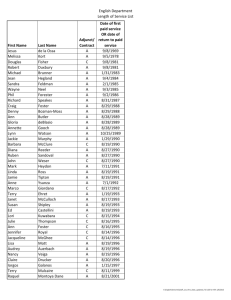State of the Art in Context Awareness
advertisement
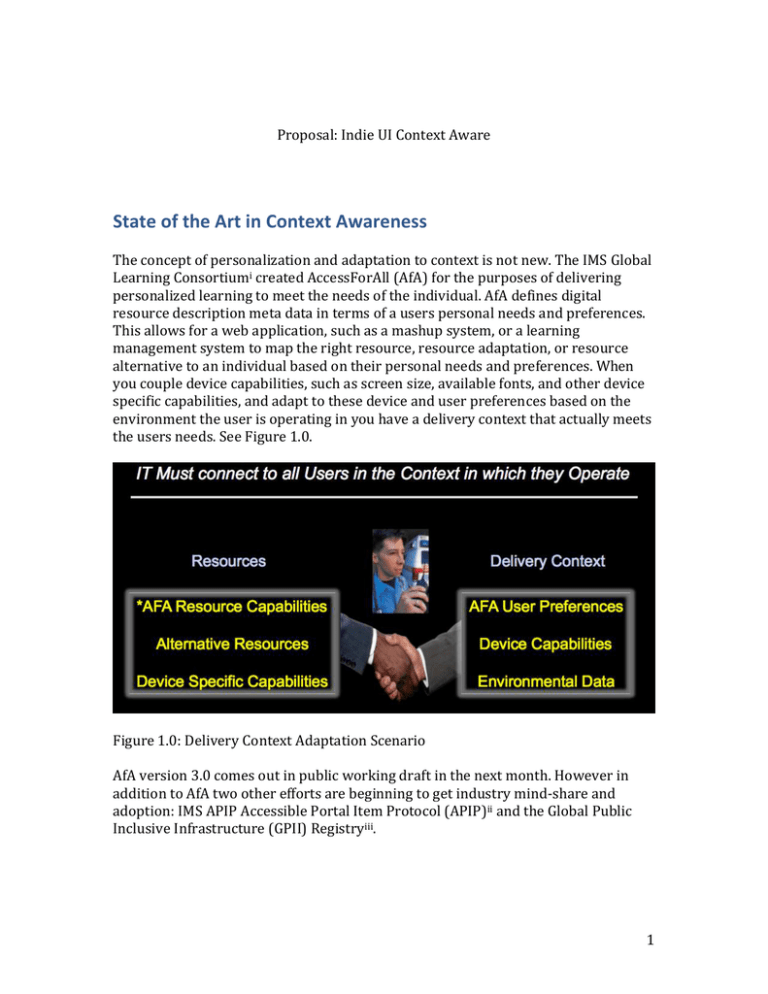
Proposal: Indie UI Context Aware
State of the Art in Context Awareness
The concept of personalization and adaptation to context is not new. The IMS Global
Learning Consortiumi created AccessForAll (AfA) for the purposes of delivering
personalized learning to meet the needs of the individual. AfA defines digital
resource description meta data in terms of a users personal needs and preferences.
This allows for a web application, such as a mashup system, or a learning
management system to map the right resource, resource adaptation, or resource
alternative to an individual based on their personal needs and preferences. When
you couple device capabilities, such as screen size, available fonts, and other device
specific capabilities, and adapt to these device and user preferences based on the
environment the user is operating in you have a delivery context that actually meets
the users needs. See Figure 1.0.
Figure 1.0: Delivery Context Adaptation Scenario
AfA version 3.0 comes out in public working draft in the next month. However in
addition to AfA two other efforts are beginning to get industry mind-share and
adoption: IMS APIP Accessible Portal Item Protocol (APIP)ii and the Global Public
Inclusive Infrastructure (GPII) Registryiii.
1
AccessForAll
The AfA Digital Resource Description (DRD) specification is intended for use in combination with the
IMS Global AfA Personal Needs and Preferences (PNP) specification v3.0, which provides a means to
describe how a user wishes to access online learning content and related applications. This part of the AfA
Specification is intended to describe aspects of digital resources or a computer system (including
networked systems) that can be adjusted to improve accessibility. The specification is not intended to
address non-digital systems that can include physical location, other people, external processes, etc.
The AfA PNP specification is intended to meet the needs of learners with disabilities and of anyone in a
disabling context. The purpose of the AfA PNP Specification is to provide a machine-readable method of
stating user needs and preferences with respect to digitally based education or learning. The AfA PNP
specification can be used independently, for example to deliver the required or desired user interface to the
user, or in combination with the AfA Digital Resource Description (DRD) to deliver digital resources that
meet a user's needs and preferences. AfA Version 3.0 is now being implemented in both the Teacher’s
Domain and the National Science Digital Library.
AfA v3.0 used semantic web technology to do the initial modeling to produce a taxonomy vocabulary not
unlike the strategy employed by WAI-ARIA.
In addition to IMS GLC’s AfA, ISO has also produced a version of AfA (in ISO this is known as ISO/IEC
24751:2008 : Individualized Adaptability and Accessibility in E-learning, Education and Training.iv) that is
harmonized with IMS GLC AfA V2. A main difference between version 3.0 and version 2.0 is v3.0’s effort
to separate AfA into a simplified core and full profile set to facilitate uptake. Also AfA V3 goes much
further to support matching of interoperable IT with assistive technologies in the core profile to support
technologies like WAI-ARIA and native platform accessibility services support. Examples of AfA V3
properties are given in Appendix A.
APIP
The learning assessment industry and the U.S. department of education is investing in APIP. The education
assessment industry has roughly $5 billion annual revenues.
APIP arose out of an US Department of ED grant (called an EAG or Enhanced Assessment Grant) to a
consortia of 8 US states, that included IMS Global Learning Consortium as a partner. The administrator of
the grant was the state of Minnesota.
Next the driver became the big Race to the Top Assessment (RTTA) program. This is a $350M multiyear
program awarded to two consortia of states - Smarter Balanced (SBAC) and PARCC. Between them they
cover 40+ states. This project will redo all of the summative assessment done in schools. While these
projects are not investing in APIP, they are requiring it in the implementation. As a consequence, all the
assessment suppliers have rallied behind APIP. IMS members focused on APIP include ETS, Pearson,
CTB McGraw-Hill, Houghton Mifflin Harcourt, Pacific Metrics, Data Recognition Corp, ACT, LiveText,
Chalk & Wire - and now IBM.
There are many more organizations that will be signing up to support APIP. Two other smaller state
consortia focused on assessment currently in the process of signing up are: Dynamic Learning Maps and
ASSETS/WIDA.
The U.S. Department of ED recently issued a $400K grant to IMS Global and the SIF Association to
collaborate on assessment standards, including APIP.
2
The LMS providers are not involved in APIP at the moment, but, it is to be expected that some will
eventually get involved as it moves from summative to formative assessment applications. APIP is based
on IMS QTI - an older version of which is implemented as IMS Common Cartridgev - i.e. there is already a
placeholder for APIP in LMS-delivered formative assessment. Also, the value APIP adds in terms of
accessibility (describing accommodations and designating inclusion orders for delivery) could be applied
very naturally to all digital learning content. It is likely that this will happen in the years ahead.
IMS Global plans to continue to harmonize APIP and IMS AccessForAll V3 to continue to grow industry
support.
Examples of APIP Preferences are given in Appendix B, included here with permission from IMS Global.
Global Public Inclusive Infrastructure (GPII) Registry
The Global Public Inclusive Infrastructure is a development effort started by Raising
the Floor to produce an open source, digital on-ramp to the Internet. Over the past
year an international development community has been working on it with initial
funding coming from a project called Cloud4All. Individual, non-profit, corporate
entities based on the Raising the Floor Consortium are being established to garner
grant funding to help build the GPII. A cornerstone of GPII is the architecture to
deliver a personalized user experience that meets the needs of the user.
GPII’s prototypical approach to a personalization architecture is described here
http://wiki.gpii.net/index.php/Architecture_Overview. Whilst it may not yet be
appropriate to standardize some features of this architecture and the precise
relationship with standards remains to be determined, the group are working
closely with the editors of ISO/IEC 24751:2008 (known hereafter as 24751) and
their requirements are being taken into account in a revision of that ISO standard
that is underway.
In particular, part of the GPII approach to personalization includes a software
registry of uniquely identified human-readable definitions of preference terms. The
plan is that the revised 24751 standard will contain a management framework for
this registry and other parts of the standard will be built upon that. Further, the
registry is planned to enable unambiguous device-independent use of terms with
storage of “Common Terms” and vendor-specific terms. The structure is currently
planned to be completely flat in that each term is unique and not related to any
others.
A number of project scheduling issues may present difficulties for Indie-UI to
completely base its work on the GPII registry but nevertheless it seems desirable to
converge approaches or adopt a common set of terms with that project should that
be possible. Some technical issues in harmonization remain to be explored but
there may be significant advantages in registering IndieUI terms in the ISO/GPII
registry in the context of adoption of usage across education markets worldwide
since ISO/IEC JTC1 SC36 ICT Standards for Learning, Education and Training is a
3
major standards body in this domain with participation (and adoption of published
standards) by a very large number of countries.
Proposal
Our proposal is to build an aggregation of terms that includes vocabulary from AfA,
APIP and GPII, and mold that into a standardized vocabulary that describes the
delivery context. This will require Coordination between W3C and IMS Global
Learning Consortium because APIP is under active development and market
adoption via IMS.
The collection of preferences, device capabilities, and any environmental
information we decide to expose should adequately form a delivery context.
In addition to the vocabulary we need to define an API in the browser that allows a
web page author to query delivery context properties that also provides a way to
register for change notifications so that when context properties change the web
application can adjust accordingly.
In the appendix are two diagrams showing the Personal Needs and Preferences and
the Digital Resource Description Core profiles along with examples of corresponding
properties and their vocabulary values. We have also included some APIP examples.
Note: APIP is expected to be evolving substantially over the next 5 years in terms of
both accessibility features and interaction types. W3C members who wish to enable
APIP accessibility features in the browser should consider joining in the IMS APIP
activity to ensure browsers can support APIP inclusion orders and assessment
interaction types.
Appendix A.
Examples from AfA 3.0
Personal Needs and Preferences Examples (PNP) – provided with permission from
IMS Global
4
5
Descriptor
Definition
Attribute name
accessModeRequired
Data type
(AccessModeValue, AccessModeValue) (see sub-section 2.2 in AfA DES [AfADES, 12]).
Value space
Container.
Multiplicity
[0..unbounded], unordered
Linguistic Indicator
Linguistic
Description
Access mode that a user seeks either in an adaptation or an original resource as a
replacement for a different access mode.
Notes
This attribute relates an “existingAccessMode” to an access mode that the user prefers,
called an “adaptationRequest.”
The example of
accessModeRequired.existingAccessMode = visual
accessModeRequired.adaptationRequest = textual
expresses this statement: “Resources that are visual should be replaced by an adaptation that
is textual.”
Descriptor
Definition
Attribute name
adaptationTypeRequired
Data type
(AccessModeValue, AdaptationTypeValue) (see sub-sections 2.2 in AfA DES [AfADES,
12], 2.5 in AfA DES [AfADES, 12]).
Value space
Container.
Multiplicitys
[0..unbounded], unordered
Linguistic Indicator
Linguistic
Description
Nature or genre of the adaptation required as a replacement for a specific access mode.
Notes
This attribute relates an “existingAccessMode” to an adaptation type that the user prefers,
called an “adaptationRequest.”
The example of
adaptationTypeRequired.existingAccessMode = visual
adaptationTypeRequired.adaptationRequest = audioDescription
expresses this statement: “Resources that are visual should be replaced by audio
description.”
6
Descriptor
Definition
Attribute name
atInteroperable
Data type
Boolean (see Table A1.1).
Value space
False – denotes that the user does not require assistive technologies support;
True – denotes that the user does require assistive technologies support.
Multiplicity
[0..1]
Linguistic Indicator
Non-linguistic
Description
A preference for resources that are compatible with assistive technologies.
Notes
Resources that are interoperable with AT should be selected whenever possible.
Interoperability is indicated by compliance with WCAG 2.0 checkpoints: 1.1.1, 1.3.1, 1.3.2,
2.4.4, 3.1.1, 3.1.2, 3.3.2, 4.1.1 and 4.1.2.The specific details of the AT are normally
provided by a user agent or the operating system. The example of ‘atInteroperable=true’
expresses this statement: “Resources that are interoperable with AT should be selected
whenever possible”.
Vocabularies
Name:
AccessModeValue
Definition:
Human sensory perceptual system or cognitive faculty through which a person
may process or perceive information.
Linguistic Indicator:
Linguistic
Value (Range):
The enumeration set is: { auditory | colour | itemSize | olfactory | orientation |
position | tactile | textOnImage | textual | visual }.
Name:
AdaptationTypeValue
Definition:
Term describing an adaptation type.
Linguistic Indicator:
Linguistic
Value (Range):
Enumerated set: { alternativeText | audioDescription | captions | e-book | haptic |
highContrast | longDescription | signLanguage | transcript }
7
Digital Resource Description (DRD) Properties:
Descriptor
Definition
Attribute name
apiInteroperable
Data type
AccessibilityAPI (see sub-section 2.1 in AfA DES [AfADES, 12]).
Value space
Container
Multiplicity
[0..unbounded], unordered
Linguistic Indicator
Non-linguistic
Description
Indicates that the resource is compatible with the referenced accessibility API.
Notes
The details of how each API is serviced may be different for each one and handled by the
User Agent and/or operating system. The example of ‘apiInteroperable=ARIAv1’ expresses
this statement: “This object implements the ARIA v1 interoperability specification”.
Name:
Definition:
Linguistic Indicator:
Value (Range):
AccessibilityAPI
Term identifying an adaptive technology API for reference in resource metadata.
Linguistic
Enumerated set: {AndroidAccessibility | ARIAv1 | ATK | AT-SPI |
BlackberryAccessibility | iAccessible2 | JavaAccessibility |
MacOSXAccessibility | MSAA | UIAutomation }.
8
Appendix B.
APIP Examples:
APIP has approximately 29 Metadata fields and work to model them in the AfA 3.0 is
underway. Below is a small sample that shows potential mapping to AfA 3.0 terms.
Acknowledgements are due to Madeleine Rothberg, WGBH for this data, provided
with permission from IMS Global.
9
APIP attribute
spoken:
spokenSourcePrefer
ence
spoken:
readAtStartPreferen
ce
spoken:
userSpokenPreferen
ce
spoken:
directionsOnly
Definition
Defines the preferred spoken audio
form. The functional meaning of the
vocabulary entries are:
Human – human voice recording is
the preferred type of speech;
Synthetic – synthesized speech is
the preferred type of speech.
Used to define if the spoken play-back
should commence from the start of a
recording or not. The functional
meaning of the vocabulary entries are:
false – spoken play-back should
start from where last play ended;
true – spoken play-back should
always start at the beginning of the
recording.
Used to define the type of material that
should be rendered using the read aloud
alternative content. The functional
meanings of the vocabulary are:
TextOnly – spoken play-back
should be used for text based
content;
TextGraphics – spoken play-back
should be used for text and
graphics based content;
GraphicsOnly – spoken play-back
should be used for graphics content
only;
NonVisual – spoken play-back
should be used for all non-visual
content.
Defines whether or not the spoken
alternative content presentation should
be applied to directive content only.
AfA v3
accessModeRequired (textual, auditory)
AdaptationDetailValue (recorded or
synthesized)
?
refinements of accessModeRequired
(textual, auditory) and (visual, auditory)
refinement of accessModeRequired
(textual, auditory)
10
References:
http://www.imsglobal.org/
http://www.imsglobal.org/apip/
iii http://gpii.net
i
ii
iv
http://standards.iso.org/ittf/PubliclyAvailableStandards/c041521_ISO_IEC_%2024
751-1_2008(Bil).zip
http://standards.iso.org/ittf/PubliclyAvailableStandards/c043603_ISO_IEC_247512_2008.zip
http://standards.iso.org/ittf/PubliclyAvailableStandards/c043604_ISO_IEC_247513_2008.zip
v
http://www.imsglobal.org/cc/
11

